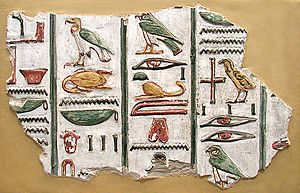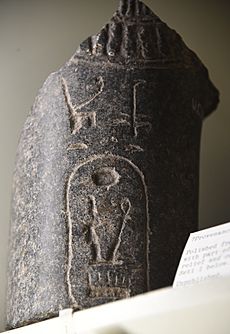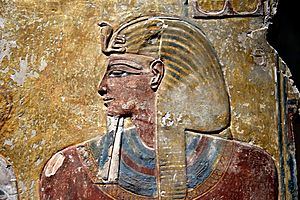Seti I facts for kids
Quick facts for kids Seti I |
|
|---|---|
| Sethi I | |
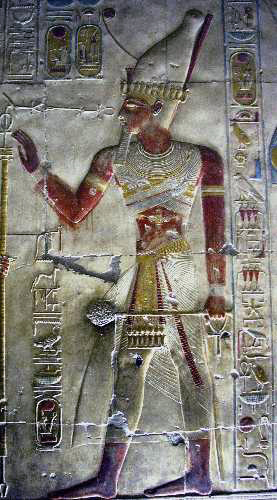
Image of Seti I from his temple in Abydos
|
|
| Pharaoh | |
| Reign | 1294/1290–1279 BC (19th Dynasty) |
| Predecessor | Ramesses I |
| Successor | Ramesses II |
| Consort | Tuya |
| Children | Tia, Ramesses II, Henutmire (?) |
| Father | Ramesses I |
| Mother | Sitre |
| Died | 1279 BC |
| Burial | KV17 |
| Monuments | Mortuary Temple of Seti I, Temple at Abydos, Great Hypostyle Hall |
Seti I was an important pharaoh of ancient Egypt. He was the second ruler of the Nineteenth Dynasty of Egypt, during a time known as the New Kingdom. He ruled from about 1294 or 1290 BC to 1279 BC. Seti I was the son of Ramesses I and Queen Sitre. He was also the father of the famous pharaoh Ramesses II.
His name 'Seti' means "of Set," showing his connection to the god Set. Like most pharaohs, Seti had several names. His main royal name, or prenomen, was Menmaatre. This means "Established is the Justice of Re." His birth name, or nomen, was Sety Merenptah. This means "Man of Set, beloved of Ptah."
Contents
Seti I's Reign
After a time of big changes under Pharaoh Akhenaten, Seti I had a main goal. He wanted to bring back order to Egypt. He also aimed to make sure Egypt controlled its lands in Canaan and Syria. These areas were being threatened by the powerful Hittites.
Seti I was a strong leader. He fought the Hittites many times. He didn't completely destroy them, but he won back most of the lands they had taken. His military victories were carved into large scenes on the temple of Amun at Karnak.
Seti I also built impressive structures. He started a funerary temple at Qurna. He also began a beautiful temple made of white limestone at Abydos. His son, Ramesses II, later finished this temple. Seti's capital city was Memphis. People at the time thought he was a great king. However, his son Ramesses II later became even more famous.
How Long Did Seti I Rule?
Historians are not completely sure how long Seti I ruled. Some believe it was 15 years, while others think it was closer to 11 years. There are no records found for Seti I after his 11th year.
One reason for the shorter estimate comes from his building projects. Seti I opened new stone quarries in Aswan in his 9th year. These were for huge obelisks and statues. However, many of these monuments were not finished when he died. His son, Ramesses II, had to complete them early in his own reign. This suggests Seti I might have died after only 10 or 11 years.
For example, Ramesses II finished decorating the southern part of the Great Hypostyle Hall at Karnak. He also completed parts of his father's temples at Qurna and Abydos. This work happened in Ramesses II's first year as pharaoh. The latest known date for Seti I is from his 11th year.
Seti I's Military Campaigns
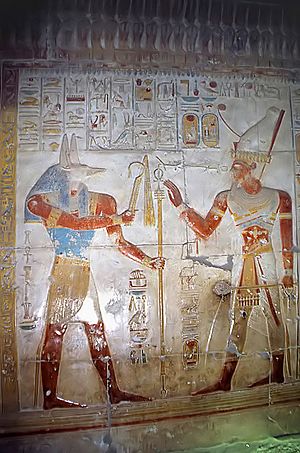
Seti I fought many wars in his first ten years as pharaoh. He led armies in western Asia, Libya, and Nubia. We know about his battles from scenes carved on the walls of the Karnak Hypostyle Hall. Also, royal stone tablets mention his fights in Canaan and Nubia.
In his first year, Seti I marched his army along the "Horus Military Road." This road went from Egypt, across the Sinai desert, to the town of "Canaan." Along the way, his army fought local Bedouin groups called the Shasu. In Canaan, some cities paid tribute to him. Others, like Beth-Shan and Yenoam, had to be captured. A stone tablet in Beth-Shan shows his victory there.
His campaign continued into Lebanon. There, the local leaders agreed to cut down valuable cedar wood as tribute for Egypt. At some point, Seti I also defeated Libyan tribes who had entered Egypt's western border. Later, in his 8th year, the Egyptian army stopped a small rebellion in Nubia. Seti I did not go to Nubia himself, but his son, Ramesses II, might have been there.
Capturing Kadesh
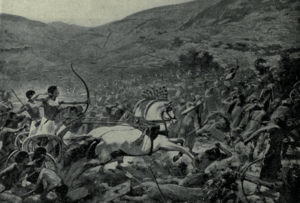
One of Seti I's greatest achievements was taking the Syrian city of Kadesh. He also captured the nearby land of Amurru from the Hittite Empire. Egypt had not controlled Kadesh since the time of Akhenaten. Seti I defeated a Hittite army that tried to defend the city. He entered Kadesh in triumph with his son, Ramesses II. He even put up a victory stone tablet there.
However, Kadesh soon went back under Hittite control. The Egyptians could not keep a permanent army there. It was too close to the Hittite homeland. It is not likely that Seti I made a peace treaty with the Hittites. He probably did not give Kadesh back willingly. But he might have agreed on the borders of their empires with the Hittite king Muwatalli. Five years after Seti I died, his son Ramesses II tried to recapture Kadesh in the famous Battle of Kadesh, but he failed.
Historians used to think Seti I rebuilt the Egyptian empire after it was lost under Akhenaten. This idea came from letters found at Amarna. These letters showed a chaotic situation in Syria and Palestine. However, newer studies suggest the empire was not completely lost. Only its northern border areas, like Kadesh and Amurru, were. Seti I left behind impressive records of his military successes. These records show his skill as a warrior.
Seti I's Burial
Seti I's tomb (KV17) was found in 1817 by Giovanni Battista Belzoni in the Valley of the Kings. It is the longest and deepest of all the New Kingdom royal tombs. It was also the first tomb to have detailed decorations in every passage and room. These decorations included beautiful carvings and colorful paintings. Some pieces, like a large column showing Seti I with the goddess Hathor, are now in a museum in Florence. This style of tomb decoration became a model for later kings.
Seti's mummy was found in 1881 in a hidden tomb (DB320) at Deir el-Bahri. It is now kept at the Egyptian Museum in Cairo. His huge sarcophagus is carved from one piece of stone. It is decorated with carvings, including the goddess Nut on the inside base. This sarcophagus is now in Sir John Soane's Museum in London.
His tomb also had a secret tunnel behind the sarcophagus. It was thought to be about 100 meters (328 feet) long. The tunnel was fully explored in 2010 by a team led by Dr. Zahi Hawass. They found that the tunnel was 174 meters (571 feet) long. However, it seemed to have been left unfinished, and no secret burial chamber was found.
Seti I's Mummy
When Seti I's mummy was examined, it seemed he was less than 40 years old when he died. This is unusual, as many other pharaohs lived to be much older. The reason for his early death is not known for sure. Some think he might have had a long-term illness, possibly related to his heart. His heart was found placed on the right side of his body during mummification. Usually, it was placed on the left. Some wonder if this was a mistake or done to help his heart in the afterlife. Seti I's mummy is about 1.7 meters (5 feet 7 inches) tall.
In April 2021, Seti I's mummy was moved. It went from the Museum of Egyptian Antiquities to the National Museum of Egyptian Civilization. This was part of a big event called the Pharaohs' Golden Parade.
See also
 In Spanish: Seti I para niños
In Spanish: Seti I para niños
- Dorothy Eady
- List of colossal sculpture in situ
- Nineteenth Dynasty of Egypt family tree
Images for kids


